Suggested Retail Price and Volume Discounts
Experts would undoubtedly agree that pricing of a product is an art as well as a part of the scientific approach. And pricing is most probably the toughest decision taken by an organization because many believe that proper pricing can enhance the sales of a product. According to Ellickson, Misra, and Nair (2012), revenues received by a firm are conditional to a certain pricing strategy, so a firm must find some sources of independent variations that induce it to switch its pricing strategy and remain active in the market.
To estimate the product price of our product “Allround” we considered our target customers, competitors pricing, and product quality. The production costs and margin were also taken into account in deciding the manufacturer suggested retail price (MSRP) of the product. The important thing that needs to be considered is that the price of the product that would be paid by a consumer would depend on the promotional allowances and volume discounts apart from the manufacturing cost of the product.
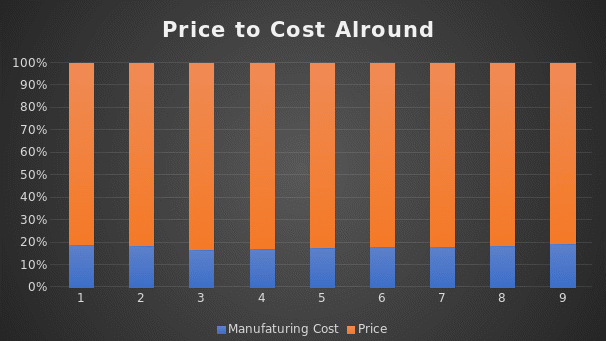
In the period one, the simulation suggested a manufacturing cost of $1.24 and we decided to offer a plain 14% promotional allowances on the MSRP. For volume discounts, we specified four layers of the purchase order from the sales force agents, the layers of purchase order offer a volume discount from 25% to 40% on the MSRP. The respective volume discounts are 25% for less than 250 units, 30% for less than 2500 but more than 250 units, 35% for more than 2500 units, and wholesalers get 40% volume discounts, whereas our suggested MSRP was $5.29 for the period one.
In the period two, we experienced a little rise in the production cost due to inflation adjustments in the raw materials which have pushed the price to $1.27. Also we took a different strategy of promotional allowances. Instead of offering a flat promotional allowance we offered different promotional allowances for different sales force members: wholesale agents received 10%, department stores and chain drug stores – 17%, grocery stores – 14%, convenience stores – 10%, and mass merch received 16% promotional allowance on the MSRP. Due to changing promotional allowance and an increased manufacturing cost, the suggested MSRP for period two was $5.59 while the volume discount remained unchanged.
During the period three, the cost of manufacturing went down to $1.2 and volume discounts remained the same. The promotional allowance was increased for department drug stores and chain drug stores to 19% and for grocery stores to 15% because of their improved sales performance. The dedicated performance of the sale force and active advertisement has increased the demand for the product “Allround” so it was decided to set the MSRP to $5.99.
In the fourth period, we introduced a new product “Allround+” and also the regular “Allround” has been performing as it was expected. The manufacturing cost of “Allround” rose to $1.25, volume discounts for the product remained the same, promotional discounts were equal to the ones in the third period except for a reduced allowance of 12% for mass merch, and the suggested MSRP remained $5.99. And for the new product “Allround+” the manufacturing cost was $1.09 with the same promotional allowances and volume discounts for the respective sales force agents; the suggested MSRP for the product was $5.29.
In the fifth period, both the product was performing better without any significant sign of changing the current pricing strategies, so it was decided not to change anything. The suggested price for both the products remained the same ($5.99 & $.5.29), also the offered promotional allowance and volume discounts equaled to the ones in the last period, except for slight changes in the manufacturing costs (Allround =$1.31, Allround+ = $1.13).
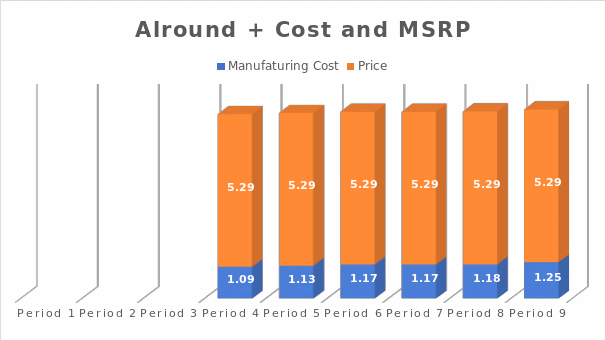
In the sixth period, a new product called “Alright” was introduced while the other two products were performing as it was expected. The new product’s manufacturing cost was $2.04 and we suggested a MSRP of $5.69. No changes in the promotional allowances and in the volume discounts were made in the period, but the inflation adjustment has increased the production cost for “Allround” ($1.35) and “Allround+” ($1.17). The suggested price for both products remained the same for the period.
For the periods Seven, Eight, and Nine all three products of the company were following a standard pricing strategy that we have set before. The strategy is to follow the promotional allowance of 10%, 19%, 19%, 19%, 10%, 12% respectively for whole sellers, department drug stores, chain drug stores, groceries, and mass march. Also, volume discounts (25% to 40%) were offered for the sales force agents in four different layers of order amount. Considering all the elements of product pricing we suggested a profitable MSRP for our sales agents: “Allround” – $5.99, “Allround+” – $5.29, and “Allstar” – $5.69.
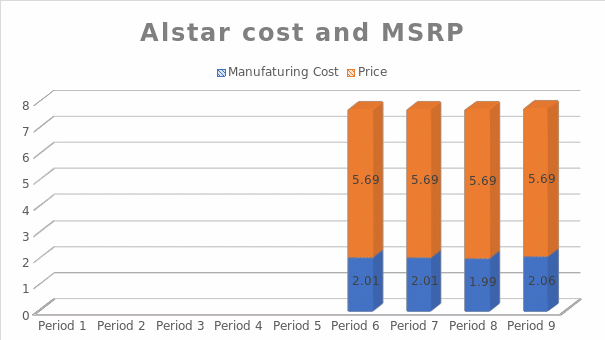
The results of the pricing strategies suggest that it had a positive impact on the sales improvements, which has initiated two more products to be launched in the subsequent periods. Also, the share price of the company would be a good indicator for measuring the strategic performance of the company. Moreover, the Salesforce agents had a strong support in increasing the sales, and as a result we had to adjust the promotional allowance for some of the sales force agents.
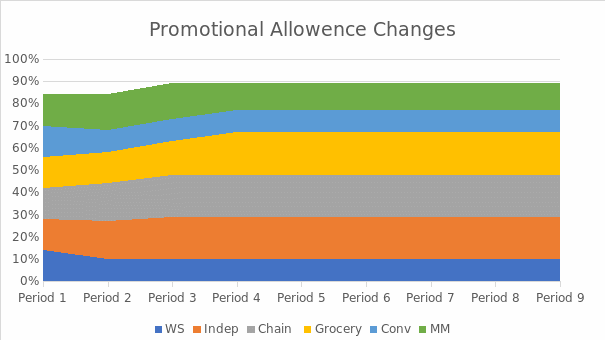
Promotional Budget and Allocation
For promoting the company products, we had to carefully consider different promotional activities both inhouse and outhouse. We allocated our promotional budgets in four different promotional activities which include cooperative advertising, product display, trial size, and coupons. Among these strategies cooperative advertisement can bring extra profits for manufacturer under certain conditions, and it occurs only when both manufacturer and retailer decide to play fairly (Yang, Xie, Dang, Xiong, 2013).
In the span of nine periods of our simulation activities, we had to increase our promotional budgets for the mentioned promotional strategies. Our promotional budgets increased by 297% (from 8.8 M$ to 33.4 M$) over the nine operational periods.
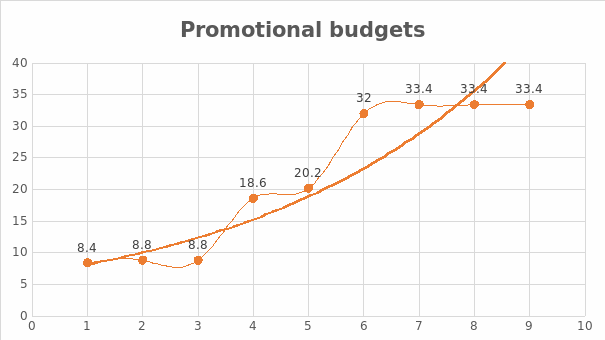
We have used trial and error strategies to determine the optimum level of promotional input for each mentioned strategy. At the very beginning we allocated the highest value (47.62%) to product display, then to cooperative advertisement (20.24%), the next strategy was the coupon (20.24%) and the least importance was given to the trial size (11.90%). During the next period we kept the same order of importance but increased the budget allocated to product display (51.14%) and co-op ad (23.86%) to see the changes in output.
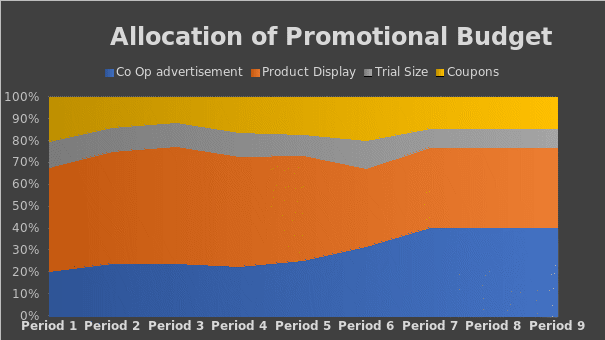
As the strategy paid off it was decided to put more value to product display (53.41%) and kept cooperative advertisement allocation the same. The fourth and fifth period was not different to the previous strategy but here we increased coupon (16%) and kept product display around 50% while cooperative advertisement allocation was around 24%-25%. In the sixth period, we significantly decreased the allocation of product display (36%) and increased co-op (32%) while the coupon promotion was receiving 20% of the budget. The further strategy suggested that we increase cooperative advertisement as it had a significant impact on the sales.
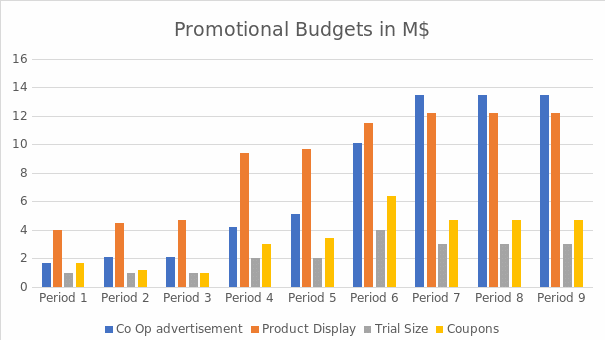
Thus, we increased the co-op advertisement budget to 40% keeping the product display at 36% and reduced the coupon-production to 14% which resulted in the best possible outcome. It was finally decided to follow the budget allocation of cooperative advertisement the highest (40.42%), followed by product display (36.53%), then coupon promotion (14.07%), and the least amount (8.98%) was allocated to the strategy of trial size.
References
Ellickson, P. B., Misra, S., & Nair, H. S. (2012). Repositioning dynamics and pricing strategy. Journal of Marketing Research, 49(6), 750-772. Web.
Yang, J., Xie, J., Deng, X., & Xiong, H. (2013). Cooperative advertising in a distribution channel with fairness concerns. European Journal of Operational Research, 227(2), 401-407. Web.